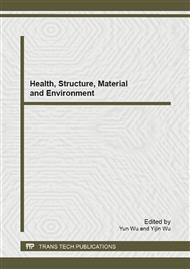[1]
Lovley DR, Blunt-Harris E L, Role of humic-bound iron as an electron transfer agent in dissimilatory Fe(III) reduction, J. Appl Environ Microbiol. 65(1999)4252-4254.
DOI: 10.1128/aem.65.9.4252-4254.1999
Google Scholar
[2]
Nevin KP, Lovley DR, Lack of production of electron-shuttling compounds or solubilization of Fe(III) during reduction of insoluble Fe(III) oxide by Geobacter metallireducens, J. Appl Environ Microbiol. 66(2000)2248-2251.
DOI: 10.1128/aem.66.5.2248-2251.2000
Google Scholar
[3]
Magnuson TS, Hodges-Myerson AL, Lovley DR, Characterization of a membrane-bound NADH-dependent Fe3+ reductase from the dissimilatory Fe3+-reducing bacterium Geobacter sulfurreducens, J. FEMS Microbiol Lett. 185(2000)5-11.
DOI: 10.1111/j.1574-6968.2000.tb09063.x
Google Scholar
[4]
Lovley DR, Holmes DE, Kelly PN. Dissimilatory Fe(III) and Mn(IV) reduction. Advance in Microbiology Physiology, J. 49(2004)219-286.
DOI: 10.1016/s0065-2911(04)49005-5
Google Scholar
[5]
Moon H S, McGuinness L, Kukkadapu R K, et al, Mocrobial reduction of uranium under iron- and sulfate-reducing conditions: Effect of amended goethite on mincrobial community composition and dynamics, J. Water Research. 44(2010)4015-4018.
DOI: 10.1016/j.watres.2010.05.003
Google Scholar
[6]
Boonchayaanant B, Nayak D, Du X, et al, Uranium reduction and resistance to reoxidation under iron-reducingand sulfate-reducing conditions, J. Water Research, 43(2009)4652-4664.
DOI: 10.1016/j.watres.2009.07.013
Google Scholar
[7]
Anderson, R.T., Rooney-Varga, J. Gaw, C.V. and Lovley, D.R. (1998) Anaerobic benzene oxidation in the Fe(III)-reduction zone of petroleum-contaminated aquifers. Environ. Sci. Technol. 32, 1222–1229.
DOI: 10.1021/es9704949
Google Scholar
[8]
Holmes, D.E., Finneran, K.T. and Lovley, D.R. (2002) Enrichment of Geobacteraceae associated with stimulation of dissimilatory.
Google Scholar
[9]
CHEN Qin, ZHAO Jia-jia, QU Dong,etc.The capability and influencing factors of microbial iron reduction in marine sediments from Bohai bay , J.Agro-Environment Science, 30(2011)1172-1179.
Google Scholar
[10]
Soil- Detection of Total Iron - Phenanthroline Spectrophotometry(FHZDZTR0122).
Google Scholar
[11]
LU Wenjing, WANG Hongtao, HUANG Changyong, W. Reichardt, Aromatic compound degradation by iron reducing bacteria isolated from irrigated tropical paddy soils, J. Journal of Environmental Sciences 20(2008) 1487–1493.
DOI: 10.1016/s1001-0742(08)62554-1
Google Scholar
[12]
Hanne Rasmussen, Per Halkjer Nielsen, Iron reduction in activated sludge measured with different extraction techniques, J. Wat. Res. 30(1996)551-558.
DOI: 10.1016/0043-1354(95)00203-0
Google Scholar
[13]
State Environmental Protection Administration.Water and wastewater monitoring and analysis methods (4th Edition), M.Beijing: China Environmental Science Press, (2002).
Google Scholar
[14]
LIU Bei-bei, QU Dong. Effects of different heavy metals on dissimilatory iron reduction, J. Northwest A & F University(Natural Science Edition), 34(2006)115-120.
Google Scholar
[15]
Qu Dong, Sylvia Schnell.Microbial reduction abiliy of various iron oxides in pure culture ture experiment, J. Acta Microbiologica Sinica, 41(2001)744-749.
Google Scholar
[16]
WANG Wei-min, QU Dong, XU Jia. Isolation of iron-reducing bacteria in paddy soil and its Fe(Ⅲ) reduction potential analysis, J. Northwest A & F University(Natural Science Edition), 36(2008)103-109.
Google Scholar
[17]
SUN Li-rong, QU Dong. Effects of electron shuttle on dissimilatory iron reduction in paddy soils, J. Northwest A & F University(Natural Science Edition), 35(2007)192-198.
Google Scholar
[18]
LIU Shuo, QU Dong. Effects of benzene analogs as sole carbon source on dissimilatory iron reduction, J. Northwest A & F University(Natural Science Edition), 34(2006)101-106.
Google Scholar
[19]
ZHAO Jia-jia, YI Wei-jie, QU Dong. The characteristics of microbial iron reduction in marine sediments from Bohai bay, J. Agro-Environment Science, 29(2010)1789-1794.
Google Scholar
[20]
Ji Shifeng. Influence of iron concentration on activated sludge performance in MBR J. Industrial water treatment, 30(2010)48-51.
Google Scholar


